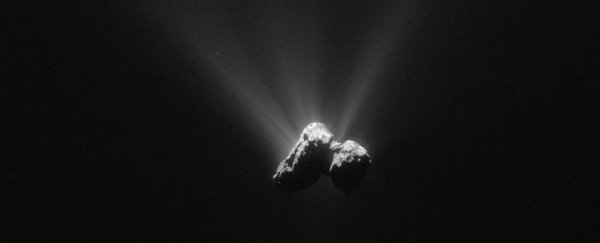It's no surprise that one of the biggest mysteries of life happens to be life itself - how exactly did it arise on Earth, and why hasn't it appeared anywhere else in the Universe (that we know of)?
While we can't begin to answer the second part of that question until we know more about what's actually out there, we're finally narrowing in on that crucial first part. Astronomers have announced that the key ingredients of life have been discovered in the atmosphere of comet 67P - that great hunk of rock that Philae managed to land on back in 2014.
Philae's battery has since died, along with any hopes of regaining contact with the iconic robot lander, but the Rosetta spacecraft that's been diligently orbiting comet 67P ever since just detected something huge - the key ingredients for life floating together in its dusty atmosphere.
To create life from scratch, you need the amino acid glycine and the element phosphorus - the base components of DNA, protein, and cell membranes - and for the first time, both of these have been found together in the halo of gas enveloping a comet.
"It shows that even the very primitive bodies like comets contain a complex chemical soup, independent of [the] Sun and Earth," one of the Rosetta team, Kathrin Altwegg from the University of Bern in Switzerland, told The Guardian. "They contain everything needed for life - except energy."
For decades, the best explanation we've had for how life originated on Earth is that the 'building blocks' were somehow delivered here, and happened to mix with the right conditions at the right time.
Scientists have been searching for the origin of these base chemicals, but the amino acid glycine has been posing something of a rather large problem. Life can't exist without it, but it's notoriously difficult to detect because of how easily it tends to shift phases.
As Belinda Smith explains over at Cosmos, glycine switches from a solid to a gas - a process known as sublimating - as soon as the temperature dips below 150 degrees Celsius.
This means our best bet for actually finding glycine in the vicinity of a comet isn't on its solid, icy nucleus, but in the cloud of gas that emanates from it once it draws nearer to the Sun along its orbital path.
No signs of glycine have been found in two of the most widely studied comets, Hale-Bopp and Hyakutake, but back in 2006, NASA's Stardust probe captured some glycine that appeared to have been shed by comet Wild-2. What's marred this discovery ever since is the fact that human contamination could never be disproved.
Now, thanks to the Rosetta Orbiter Spectrometer for Ion and Neutral Analysis (ROSINA) device onboard the Rosetta spacecraft, we finally have unequivocal evidence that this element can exist within the atmosphere of a comet, alongside phosphorous and other molecules, hydrogen cyanide and hydrogen sulphide - and without the complications of human intervention.
"This is the first unambiguous detection of glycine in the thin atmosphere of a comet," Altwegg told Cosmos.
Proving that glycine can exist within the halo of a comet means the hypothesis that comets or asteroids delivered the key ingredients of life to Earth is only getting stronger.
Altwegg told Nicola Davis at The Guardian that the glycine is likely to have formed billions of years ago in the ice layers that surrounded the dust particles that gave rise to our Solar System - known as the protosolar nebula.
These dust grains ended up forming comets, which could have bombarded with early Earth to give it the tools it needed for life to form. This means that the same process could happen elsewhere in the Universe, as long as there's water for the other key amino acids to form.
"They could have sparked life on Earth by impacting on an ocean," she told Davis. "But even nicer is the idea that we have shown that amino acid is 'universal'. Its formation can happen in any protosolar nebula and then maybe spark life somewhere else."
The results have been published in Scientific Advances.
